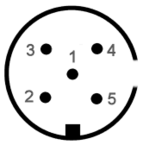Cube plug
The cubic connector is a variant of the DIN connector that is used almost exclusively for headphones . It is now rarer and has been replaced by various versions of the jack plug .
The name comes from the arrangement of the pins in the connector in the shape of the number five on a dice .
Design and pin assignment (illustration on the plug-in side)
| Plug: | Rifle: |
Terminal assignment:
1 = nicht belegt (im Stecker oft nicht vorhanden) 2 = Rückleitung linker Kanal – weiß 3 = Rückleitung rechter Kanal – braun 4 = Hinleitung linker Kanal – gelb 5 = Hinleitung rechter Kanal – grün
The return lines are not connected to each other in the headphones .
The ring around the connector is interrupted between pins 4 and 5, but not between pins 2 and 3.
particularities
The plug can be inserted rotated by 180 °, so that, depending on the plug position in the socket, a switch contact between pin 4 and 5 can be activated to switch off the loudspeakers. Since the return lines are not connected to each other, perfect stereo operation is possible even if the connector is rotated by 180 °. When plugged in twisted, the phase position of both systems is also absolutely twisted.
For the same reason, the headphones can also be operated on floating bridge power amplifiers.
The Sennheiser company has developed a special form of the cubic connector, the so-called family connector or stacking connector, which can be cascaded in almost any way thanks to a built-in socket at the rear end. The individual headphones are connected in parallel.
adapter
The pin assignment for an adapter to 6.35 mm jack (TRS):
1 = nicht belegt
2 und 3 = Hülse sleeve (GND)
4 = Spitze tip (linker Kanal)
5 = Ring ring (rechter Kanal)
Independent channels
This connector allows headphones and other balanced and / or floating sources or loads to be connected. With jacks, the common and relatively unreliable ground contact leads to crosstalk, especially with low-resistance listeners. Cube 5 lines can also be extended as required, individual systems can be rotated in phase or combined as required. This is not possible with handles.
These advantageous electrical data are offset by their unwieldiness.


